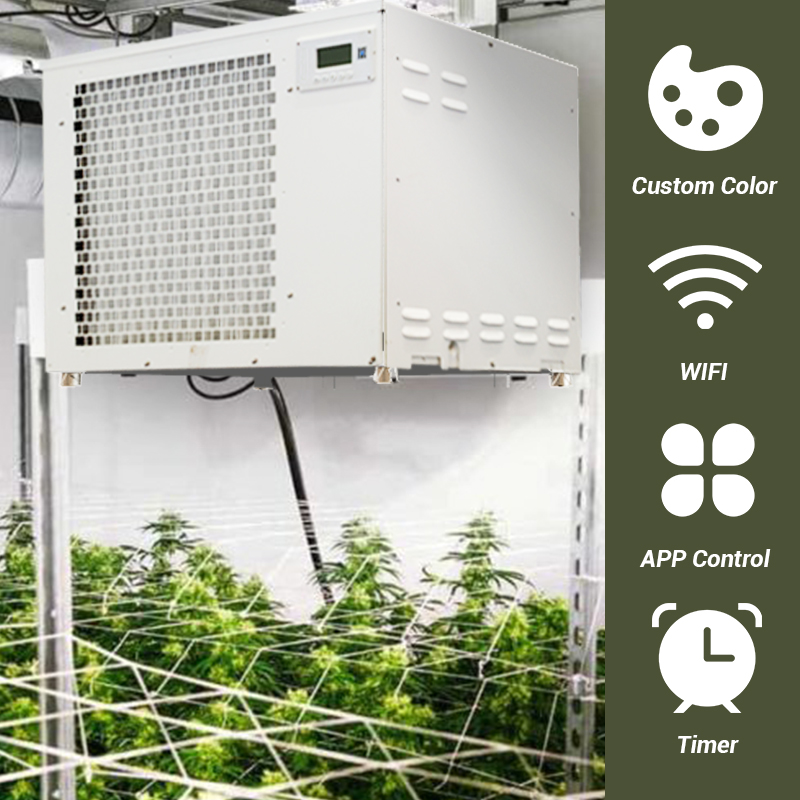How much energy does a greenhouse dehumidifier use?
The energy consumption of a greenhouse dehumidifier can vary depending on several factors, including the size and capacity of the dehumidifier, the moisture level in the greenhouse, the desired humidity setpoint, and the operating conditions.
1. Dehumidifier capacity: The dehumidification capacity of the unit, typically measured in liters or pints per day, indicates the amount of moisture the dehumidifier can remove from the air. Higher-capacity dehumidifiers generally consume more energy than lower-capacity ones. The dehumidification capacity of the PRO330 indoor grow dehumidifier is 330PT/day (@ 26.7℃/60%RH).
2. Relative humidity (RH) setpoint: The desired RH level in the greenhouse affects the dehumidifier's runtime and energy consumption. If the dehumidifier needs to maintain a lower RH level, it will typically run for more extended periods, leading to higher energy usage. Different plants in different growth stages have specific requirements for RH.
3. Moisture load: The amount of moisture present in the greenhouse air impacts the dehumidifier's workload and energy consumption. Greenhouses with higher moisture levels due to factors like excessive watering or damp conditions may require the dehumidifier to work harder and consume more energy.
4. Operating conditions: Temperature and airflow within the greenhouse can affect the dehumidifier’s performance and energy consumption. Warmer temperatures generally increase the efficiency of dehumidifiers, while colder temperatures can reduce their effectiveness. The operation temperature range of the PRO330 dehumidifier is 5℃-35℃ and the working RH range is 20%-85%.
5. Dehumidifier efficiency: The efficiency of the dehumidifier itself plays a role in energy consumption. Energy-efficient models with advanced features and technology may consume less energy while still effectively removing moisture from the air. The efficiency of our PRO330 dehumidifier is 3.5L/kWh, which indicates the amount of electrical energy consumed by the dehumidifier over a certain period.
Preair is a famous dehumidifier manufacturer that provides different types of dehumidifiers for sale. The energy-efficient PRO series dehumidifiers for greenhouses are warmly recommended by customers worldwide.
How to save energy when using the cultivation dehumidifier?
When using a cultivation dehumidifier in a greenhouse or indoor cultivation setup, there are several strategies you can implement to save energy.
1. Properly size the dehumidifier: Choose a greenhouse dehumidifier that is appropriately sized for your cultivation area. Oversized dehumidifiers can consume more energy than necessary. Consult the manufacturer to select a dehumidifier for a grow tent with the right capacity for your specific needs.
2. Optimize ventilation: Proper ventilation can help remove excess moisture from the air. Use natural ventilation whenever possible, such as opening windows or vents, to allow for air circulation. This can reduce the workload on the dehumidifier and lower energy consumption.
3. Seal air leaks: Identify and seal any air leaks in the cultivation area, including doors, windows, vents, and other openings. Air leaks can allow moisture to enter the space and increase the load on the dehumidifier. Properly sealing these leaks helps maintain the desired humidity level and reduces energy waste.
4. Control humidity levels: Set the dehumidifier to maintain the ideal humidity level for your plants, rather than aiming for excessively low humidity. This can help optimize energy consumption. Monitor the humidity regularly using a hygrometer and adjust the dehumidifier settings accordingly.
5. Optimize temperature settings: Maintain appropriate temperature levels in the cultivation area. Higher temperatures can enhance the efficiency of dehumidifiers, allowing them to remove moisture more effectively. However, ensure the temperature remains within the optimal range for plant growth.
6. Schedule dehumidifier operation: Program the dehumidifier to operate during periods when humidity levels are typically higher. For instance, running the dehumidifier during the night when the outside air is cooler and humidity tends to rise can be more energy-efficient than operating it during the day.
7. Maintain the dehumidifier: Regularly clean and maintain the dehumidifier according to the manufacturer's instructions. A well-maintained dehumidifier operates more efficiently, reducing energy consumption. Clean or replace filters as recommended to ensure proper airflow.
8. Energy-efficient equipment: Consider investing in energy-efficient dehumidifiers that have high energy ratings or Energy Star certifications. These models are designed to consume less energy while still effectively controlling humidity.
Implementing these energy-saving strategies can help optimize the operation of your cultivation dehumidifier, reducing energy consumption and associated costs while maintaining optimal humidity levels for your plants.
Post time: Jul-11-2023
 +86-13376814803
+86-13376814803  robert@hzhongtai.com
robert@hzhongtai.com 














